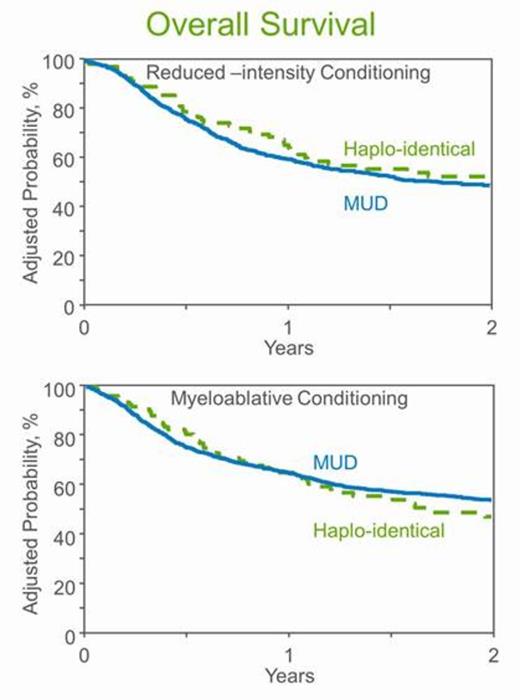Abstract

Background: Increasing numbers of haplo-identical transplants are being performed and the most common approach in the United States includes transplantation of an unmanipulated graft with tacrolimus, mycophenolate and post-transplant cyclophosphamide for GVHD prophylaxis. In this analysis we compare the early outcomes after haplo-identical transplantation with this GVHD prophylaxis with that after conventional HLA-matched unrelated donor transplant approaches (MUD).
Methods: Included are 2174 patients with AML aged 21-70 years and transplanted between 2008 and 2012. Cox regression models were built for recipients of myeloablative (N=1245 MUD compared with N=104 haplo-identical) and reduced intensity (N=737 MUD compared with 88 haplo-identical) conditioning transplants. Primary endpoint was 2-year overall survival. With median follow-ups of 2-3 years, surviving patients in all treatment groups were censored at 2-years.
Results: Characteristics of recipients of myeloablative transplantation were similar across the two treatment groups except peripheral blood (PB) was the predominant graft with calcineurin inhibitor (CNI) with methotrexate the predominant GVHD prophylaxis for the MUD group compared to predominantly BM grafts with CNI, mycophenolate and post-transplant cyclophosphamide for the haplo-identical group. Most regimens were non-irradiation containing, 74% for MUD and 78% for haplo-identical transplants. Characteristics of recipients of reduced intensity conditioning transplants differed by treatment groups; recipients of MUD transplants were older (median age 62 vs. 57 years), more likely to report performance score 80 or lower, be in first complete remission at transplantation and shorter interval from diagnosis to transplantation. PB was the predominant graft for MUD and BM, for haplo-identical transplants. The conditioning regimen for reduced intensity haplo-identical transplants was uniform (TBI 200 cGy, cyclophosphamide, fludarabine) and for MUD transplants, it was predominantly an alkylating agent and fludarabine (79%). Day-30 cumulative incidence of neutrophil recovery was higher after myeloabative MUD compared with haplo-identical transplants (97% vs. 90%, p=0.01). Neutrophil recovery was not different after MUD and haplo-identical reduced intensity conditioning transplants (96% vs. 93%, p=0.25). Table 1 shows the results of multivariate analysis for non-relapse mortality (NRM), relapse and overall survival. Overall survival is not significantly different after haplo-identical and MUD transplants with either the myeloablative or reduced intensity conditioning approaches. The 2-year survival rates adjusted for age, disease status and interval from diagnosis to transplant after myeloablative MUD and haplo-identical transplantation were 54% (95% CI 51-57) and 47% (95% CI 37-57), respectively (p=0.22). The corresponding 2-year survival rates after reduced intensity conditioning transplantation were 49% (95% CI 45-53) and 53% (95% CI 42-63), p=0.25. We also explored for difference in survival with in vivo T-cell depletion in the myeloablative (HR 0.81, p=0.19) and reduced intensity (HR 1.18, p=0.33) MUD groups compared with the corresponding haplo-identical groups (baseline HR 1.00) and found none. We tested for a transplant center effect on survival and found none.
Conclusion: With the available data, 2-year survival rates for AML after myeloablative or reduced intensity conditioning transplants are comparable after conventional MUD transplant approaches and haplo-identical transplant with the post-transplant cyclophosphamide approach. Longer follow-up of haplo-identical transplant recipients as well as confirmation of these findings in a larger population, are needed before wide spread adoption of selecting haplo-identical donors over HLA-matched unrelated donors.
| Transplant Conditioning Regimen | ||
| Outcomes | Myeloablative Hazard Ratio | Reduced intensity Hazard Ratio |
| NRM | ||
| Haplo-identical | 1.00 | 1.00 |
| MUD | 1.07; p=0.82 | 2.35; p=0.03 |
| Relapse | ||
| Haplo-identical | 1.00 | 1.00 |
| MUD | 0.88; p=0.40 | 0.76; p=0.09 |
| Survival | ||
| Haplo-identical | 1.00 | 1.00 |
| MUD | 0.93; p=0.61 | 1.13; p=0.46 |
| Transplant Conditioning Regimen | ||
| Outcomes | Myeloablative Hazard Ratio | Reduced intensity Hazard Ratio |
| NRM | ||
| Haplo-identical | 1.00 | 1.00 |
| MUD | 1.07; p=0.82 | 2.35; p=0.03 |
| Relapse | ||
| Haplo-identical | 1.00 | 1.00 |
| MUD | 0.88; p=0.40 | 0.76; p=0.09 |
| Survival | ||
| Haplo-identical | 1.00 | 1.00 |
| MUD | 0.93; p=0.61 | 1.13; p=0.46 |
No relevant conflicts of interest to declare.
Author notes
Asterisk with author names denotes non-ASH members.

This icon denotes a clinically relevant abstract


This feature is available to Subscribers Only
Sign In or Create an Account Close Modal